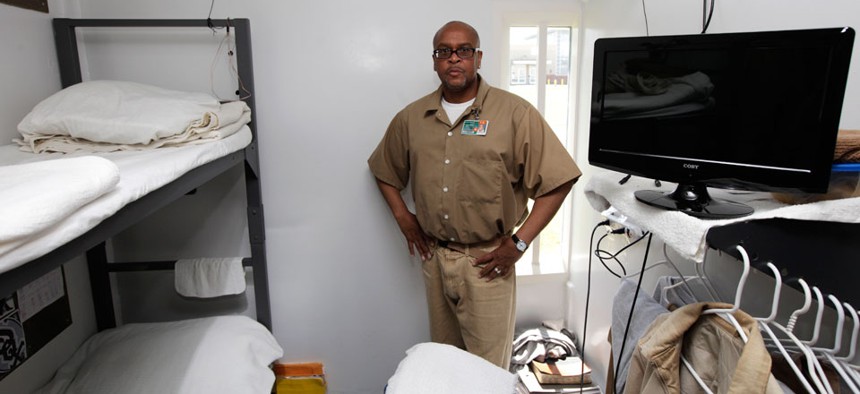VA and Defense Chiefs Confront Reality of 700,000 Incarcerated Veterans

Army vet Donald Betts in 2012 in his cell in Aberdeen, Wash., where state officials are working to better coordinate benefits for imprisoned vets. AP Photo/Ted S. Warren
Conference focuses on vets jailed due to mental health, substance abuse.
The 700,000 veterans consigned to the dustbins of society -- prisons and jails -- won some top level attention this week at the first national Vet Court Conference in Washington, which brings together 1,000 judges, mental health and substance abuse professionals and the leadership of the Veterans Affairs and Defense Departments.
The conference, sponsored by the Justice for Vets division of the National Association of Drug Court Professionals, focuses on veterans involved in the criminal justice system as a result of substance abuse and mental health problems. There are some grim statistics behind this issue: One in six returning veterans from Iraq and Afghanistan suffers from a substance abuse disorder; since 2004, the number of veterans treated for mental illness and substance abuse has increased 38 percent, and 81 percent of arrested veterans had a substance abuse problem.
The first veterans treatment court in the country was established in 2008 by Judge Robert Russell in Buffalo, N.Y. The goal was to divert veterans charged with felony or misdemeanor nonviolent criminal offenses to a specialized criminal court that emphasizes treatment and rehabilitation guided by veteran health care professionals, veteran peer mentors and mental health professionals.
Since then, the number of veteran courts has grown to 130. Melissa Fitzgerald, senior director of Justice for Vets, said the specialized courts “have gained national prominence as the most innovative solution for veterans entering the criminal justice system. Veterans treatment courts stand between the veteran and a felony conviction, incarceration, or worse, ensuring that when returning service members are arrested because of a substance abuse and/or mental health disorder, they receive the structure, treatment and mentoring they need to get their lives back on track.”
VA Secretary Eric Shinseki, in his keynote speech at the conference Monday, said that homelessness also stands out as another key factor for incarceration. He said, “nearly 58,000 [veterans] are estimated to be homeless on any given night. I am told that incarceration is the No. 1 predictor of homelessness.
“If we are going to break the cycle between incarceration and homelessness, we will have to raise our level of collaboration and leverage all our assets to address these factors, which seem so pervasive when dealing with troubled Veterans—depression, insomnia, substance use disorder, pain, failed relationships.”
Shinseki said this includes VA taking a sharp look at its own use -- some critics say abuse -- of addictive, prescription pain killers, such as Oxycontin.
Over the past three years, Shinseki said, VA has discouraged overuse of opiates in favor of other medications and therapies and has taken steps to reduce the use of opiates. Since 2012, the Minneapolis-based VA health care system has cut its use of high-dose opiates by more than 50 percent and all but eliminated Oxycontin prescriptions, decreasing its use by 99 percent., Shinseki said.

Broken Warriors
is an ongoing series on mental health issues in the military.
VA has hired 172 justice outreach specialists who work directly with the courts “to see that veterans who are before the court or already in jail get the care they need and that courts are supported in their consideration of best possible alternatives to incarceration,” Shinseki said. Those specialists worked with 5,800 veterans in the first year of the program in 2010, a number that jumped to 36,000 this year, he said.
Veterans in the justice system aided by VA have averaged seven prior arrests, Shinseki said, and 20 percent have spent a year or more behind bars.
Vet courts do make a difference, he said. “Two-thirds of veterans before the treatment courts successfully complete their treatment regimens,” he said. “When they receive VA services, they experience an 88 percent reduction in arrests from the year prior to the year after treatment court admission. They also benefit from a 30 percent increase in stable housing in the year after.”
Christopher Deutsch, spokesman for the National Association for Drug Court Professionals, said it is hard to truly quantify how many veterans from the long wars in Afghanistan and Iraq are in prison, as the last report from the Bureau of Justice Statistics on incarcerated veterans was released in 2000, a year before the start those wars
A November 2011 study , conducted by researchers at VA’s Connecticut health care system and the Yale Medical School Department of Psychiatry, focused on 30,000 jailed veterans and determined that Afghanistan and Iraq veterans constituted only 3.9 percent of that population.
Iraq and Afghanistan veterans in the survey, the report said, were more likely to report combat stress and were 26 percent less likely to have a diagnosis of drug abuse or dependence, but three times more likely to have combat-related post traumatic stress disorder.
VA has developed a new system to identify incarcerated veterans called the Veterans Reentry Search Service to enable corrections officials to quickly and easily identify any veteran in their institutions. Shinseki has “written each governor encouraging collaboration through VRSS,” he said. “With greater participation, we will be better able to identify and treat veterans in need of our services, hopefully reducing their appearances before you. We intend to make VRSS available to the courts, as well.”
The Vet Court Conference concludes Wednesday with an address by Army Gen. Martin Dempsey, chairman of the Joint Chiefs of Staff.



